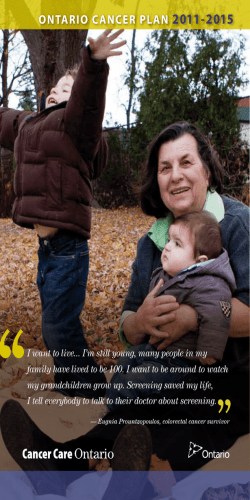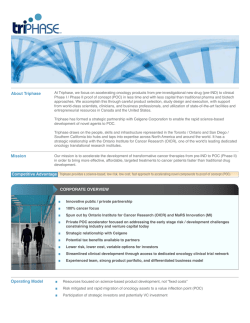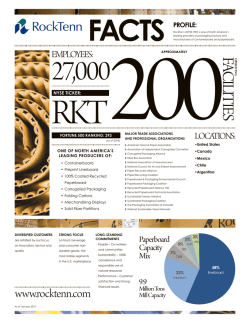
FUll-DAy KINDErGArTEN IN ONTArIO
Implementing HighScope: Canada Pay Now or Pay Later Full-Day Kindergarten in Ontario by Moya Fewson I s there such thing as a “perfect place” for children and their families? What does this perfect place look like when you envision it? Whom does it serve? What is its focus? Where is it located? Whose needs does it take into account? Is it even possible to achieve? Many early childhood educators in Ontario have such a vision. In their perfect place, centers provide support prenatally, during infancy, early childhood, and through the school years, and focus on health, nutrition, and outdoor experiences. At-home parents have access to drop-in centers and playgroups. Working parents can send all of their children to one place and feel secure that they are well cared for and well educated with an inquiry-driven curriculum. In this perfect place, programs have a focus on problem solving, self-regulation, and social and emotional development. Centers are located in neighborhood schools and are paid for by tax dollars. All children go to school, perhaps even beginning at age two, and are placed in developmentally appropri- highscope.org In 2010, Ontario initiated the now province-wide policy of universal full-day kindergarten. ate, play-based programs with degreed teachers (BAs) and early childhood educators (ECEs) with diplomas (associate degrees) working in partnership. Children are cared for before and after traditional school hours in a school building converted for just this purpose, and school boards are responsible for this care. Our best future In his comprehensive plan of action for implementing early childhood education in Ontario, With Our Best Future in Mind, Charles Pascal referenced the Perry Preschool Project, demonstrating how early intervention, especially for children in low-income households, improved school performance and life experiences (Pascal, 2009). He put faith in the findings that showed children in high-quality early education programs had a greater chance of graduating high school, going to college, avoiding arrests and jail time, and having meaningful employment. Pascal believed that dollars invested in the early years would provide a solid economic return through a reduction in future social service costs. The vision of Family Centers with a seamless day, caring for children from before birth through elementary school, morphed into a program for four- and five-year-olds in Ontario. Full-Day Kindergarten (FDK) was born. The Provincial government was slated to fund this program with a $900 million budget. Offered in high-needs areas beginning in the fall of 2010, FDK is now fully implemented across the province at all socioeconomic levels. How successful has this program been? It depends on whom you ask. It seemed like a good idea at the time, but not everyone involved with the program shares Pascal’s commitment to this ReSource Spring 2015 13 Implementing HighScope: Canada Proponents of Pascal’s plan believe strongly that early intervention improves school performance and life experiences. vision of a perfect place for children and their families. costs, and some teachers stress that increased funding for FDK has diminished resources for other important programs. Other staff worry that little emphasis has been given to curriculum and pedagogy in the early years. The “ideal partnership” anticipated between teachers and ECEs, it turns out, is often not so ideal. Although some teaching teams work very well, they’re always hierarchal. Early childhood educators, many of whom are well trained and have a solid background in the developmental needs of the children in their care, find themselves in an assistant role. Those who used to plan group activities and implement the COR now clean tables and fill paint pots. “I have a lot of training in child development. I am an endorsed HighScope teacher and I truly understand programming for four-year-olds — better than the teacher,” said one. The contracts of ECEs don’t include additional planning time, so they cannot contribute to the programming for the day, and they aren’t part of the evaluation process. Unlike teachers, whose contracts are permanent, ECEs have renewed contracts and are laid off during the summer. Perhaps most discouraging of all, there is no career ladder for early childhood educators. In child care centers, they could be promoted all the way up to director. But once in the school system as an ECE in the FDKs, without further education, that’s where they top out. For schools, a mixed blessing Some communities, to be sure, are delighted with FDK. The infusion of four- and five-year-olds has kept schools with declining enrollment from closing. Teachers and their unions are also happy: Jobs have been maintained and created. Capital funding has been provided to schools to upgrade playgrounds and make classrooms more suitable for younger children. The vision of Family Centers with a seamless day, caring for children from before birth through elementary school, morphed into a program for four- and five-year-olds in Ontario. Full-Day Kindergarten (FDK) was born. Funding has been provided by the provincial government to make existing infrastructure more suitable for 4- and 5-year-olds. Other schools are less pleased with the results. The influx of these young children means fewer classrooms in fully-enrolled schools are available to older children. Some of these youngsters have to be bused to schools outside of their community, increasing busing 14 ReSource Spring 2015 highscope.org Many questions unanswered for parents Many parents, of course, are delighted with FDK. They can drop off their children (except for infants and toddlers) in one spot and pick them up in the same place. Community child cares have moved in to fill the need for before- and after-school care (“wrap-around care” — paid for by parents) in the school buildings, which makes life easier for working parents. And all parents are pleased that day care fees have been reduced. Given that there is no effective assessment tool, and principals don’t have time to routinely observe every classroom, how do they know that the program really is play-based? But some have expressed concern about children so young being away from home. Their children are exhausted, these parents say, and overworked. They worry that overworked staff can’t always attend to individual children’s needs. Of great concern for both parents and teachers is that there is no cap on numbers for FDK. Four- and five-yearolds are in the same group, which may be considerable in size — perhaps 40 children — often in a small space. This leaves many teachers frustrated, and with this many children in one space, parents wonder whether the curriculum can be implemented properly. Given that there is no effective assessment tool, and principals don’t have time to routinely observe every classroom, how do they know that the program really is play-based? Here and now: taxpayers lament high cost of FDK Even if parents are generally happy with the FDK program, as taxpayers, they are not. The $1.3 billion price tag highscope.org The cost of implementation has far exceeded the proposed budget, leading some to call for an end to full-day kindergarten in Ontario. far exceeds the proposed budget. Don Drummond, an advisor brought in by the McGinty government to fix the increasing provincial debt, recommended cancellation of the FDK program. In response to Ontario’s budgetary woes, other provinces have delayed implementation of their own programs. But the most important questions is, has this program supported children? Has it, as Charles Pascal envisioned, “changed lives”? A recent government study has found that children who attended FDK are indeed stronger in reading and communication at the beginning of first grade (Ministry of Education, 2013). Children did, in fact, do better on academic testing in reading, writing, and math. However, that data is based on children in full-day kindergarten compared to half-day programs, and doesn’t consider whether children have gone to high-quality early education programs or not. That said, the benefits of FDK seem to diminish over time, and according to the study, there appears to be no academic advantage to FDK past first grade (Ministry of Education, 2013). The program is too new to evaluate whether children will regain any advantage as they progress through school, or what the long-term effects in areas other than academics may be. In 2014, third graders from the original cohort in FDK took the standardized academic achievement test for the first time. The results of this one test could be viewed by some as an indicator of the success or failure of the FDK program. But it’s not just academic performance that has failed to meet expectations. Although its original focus was to be on social and emotional development and self-regulation, it’s unclear whether children in FDK are better prepared to make decisions, reflect on those decisions, negotiate, compromise, or problemsolve. Perhaps that’s because there is no assessment in place to determine if the program really is “inquiry driven.” ReSource Spring 2015 15 Implementing HighScope: Canada With results forthcoming, the original full-day cohort took the standardized academic achievement test for the first time, in 2014. It will be more interesting to take a look 50 years from now and ask if this experience made a real difference in the lives of these children. Was there an economic return? Did more complete high school and own their own homes? Did fewer go to jail? Did the FDK program replicate the outstanding results of the Perry Preschool Study? We can’t answer those questions now. So what to make of all these contrasting opinions? Certainly the idea, and the ideal, of a program for children that supports families is a wonderful thing. With one of the highest percentages of women in the workforce of any country, it is unlikely that many women (or men) in Canada will leave the workplace to stay home with their children (OECD, 2013). Clearly, child care is a need for many. The ideal child care solution would likely include some, if not all, of the elements in Pascal’s original vision. educators have the training required to implement a truly enriched program. Children are not always engaged in inquiry learning and play-based experiences, as teachers often fall back on traditional, teacher-directed programs. All too often, these teacher-directed programs require children to sit still, use work sheets, and answer in rote — tasks we know are inappropriate for little children. Time-out is still common, leaving little opportunity for learning problemsolving skills and self-regulation. Planning is seldom a part of the daily routine. Children spend much more time being quiet — and at such a sensitive time for learning language — than they would in a true active-learning environment. And they continue to be educated for jobs that no longer exist. In many ways, our billions of dollars haven’t changed much at all. But perhaps instead of fretting over the cost of an ideal program, we should consider it an investment, and instead of cutting costs, perhaps we should pay more to get the quality that advocates like Charles Pascal intended. With a pay-now approach, we can provide parenting centers, enlist school boards to run wrap-around care, and provide the training to create truly appropriate, inquiry-based learning that is evaluated and assessed. With a pay-now approach, we can provide parenting centers, enlist school boards to run wraparound care, and provide the training to create truly appropriate, inquiry-based learning that is evaluated and assessed. This is not likely to be a popular option with tax payers, unfortunately. Both the Conservative Party and the New Democratic Party have stated that Some worry that 4- and 5-year-olds are too young to spend a full day at school, while working parents especially are thrilled with the ease of service and fee reductions. The vision and the reality FDK as implemented in Ontario has not yet matched the original vision of Family Centers. Although there are excellent teachers doing wonderful things with and for children, not all 16 ReSource Spring 2015 highscope.org they will dismantle FDK if elected. People continue to scrimp today (lower taxes, save money) rather than taking the longer view of what will happen tomorrow with higher social service costs and a less equitable society. Either we pay now, or we pay later. Perhaps there is a middle road. Canada, like the US, does not have a national child care policy. It needs one. A national policy modeled on Quebec’s, for instance, could fund programs that are licensed and regulated at a reasonable cost. Quebec runs highly effective, parent-friendly early childhood centers. Some use HighScope certified teachers and trainers implementing the HighScope Curriculum. Although not universal as originally planned, child care centers offer early education to all children, not just those in economic need, at $7 per day. Of course, this program too is being investigated — not because it hasn’t been effective, but because it costs money. As an engrained part of Quebec’s culture, though, this program seems like it’s here to stay — unlike our own in Ontario. If we are able to bring FDK in line with Pascal’s vision, Ontario...could soon possess an early education model worthy of national emulation. Even if we don’t choose to follow Quebec’s model, we in Ontario will need to make a decision soon. The failure of FDK to meet ideal standards in just four years is no reason to scrap that model altogether. It’s far from perfect, but if we are able to bring FDK in line with Pascal’s vision, Ontario itself could soon possess an early education model worthy of national emulation. The benefit of paying now As HighScope practitioners, we celebrate the original vision. We celebrate children. Jobs and wages and tax bur- highscope.org Moya Fewson was formerly the coordinator of the Early Childhood Education program at Sheridan College in Ontario. She is a certified HighScope trainer who co-authored Lesson Plans for the First Thirty Days with Beth Marshall and Shannon Lockhart. Moya received the David Weikart Award in 2008. Upon retiring from Sheridan, she began the HighScope Teacher Education Centre in Canada. A willingness to spend more today could save money in the future with a reduction in social service costs. dens all have to be part of the equation, to be sure. But the real purpose here is to provide an equitable foundation for all Canadians, starting at birth. That won’t be cheap, but it’s worth it. HighScope conducted the seminal research on the effects of quality early intervention for at-risk children in the Perry Preschool Project. We are thankful to have champions like Charles Pascal, who believe early education is so important that it’s worth paying for. In 50 years, we as a society hope to reap the benefits of early education, both academically and economically. More importantly, and what is certain, individuals and their families, with our support, can begin reaping those benefits now. References: Government of Ontario, Ministry of Education. (2013). A meta-perspective on the evaluation of full-day kindergarten during the first two years of implementation. Retrieved from http://www.edu.gov.on.ca/kindergarten/FDKReport2013.pdf Organization for Economic Cooperation and Development. (2013). Employment rate of women % of female population (15-64). doi: 10.1787/20752342-table5 Pascal, C. E. (2009). With our best future in mind: implementing early learning in Ontario. Retrieved from YWCA Canada website: http://ywcacanada.ca/data/research_ docs/00000001.pdf Center for Early Education Evaluation The Center for Early Education Evaluation (CEEE) is the research and evaluation arm of HighScope. The CEEE provides rigorous impact evaluations, instrument validity research, and comprehensive evaluation consultations to states and provider agencies. Visit highscope.org/ceee to learn more. ReSource Spring 2015 17
© Copyright 2025





